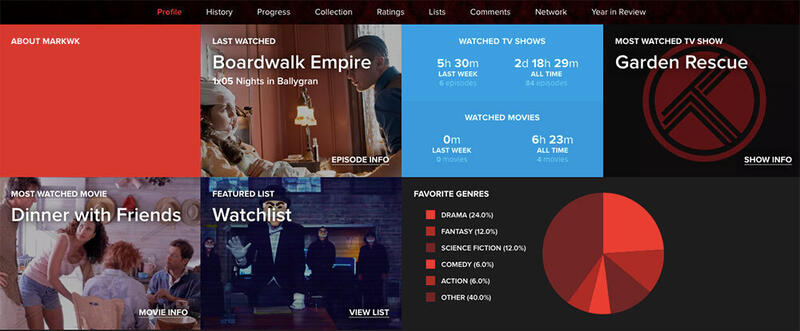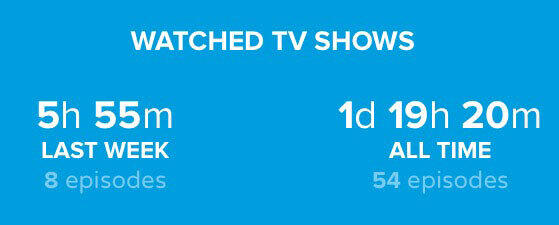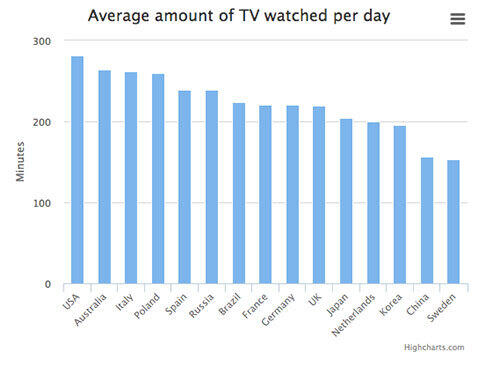![]()
How do you spend your downtime? What movies and TV shows are you watching? Are you addicted to TV or just enjoying some relaxing entertainment before bedtime?
Most self-tracking is about your active time. You might use time tracking to look at productivity and computer usage or an activity tracker to record your steps and exercise. Habit trackers and life logging tools can help you record even more of your life and there are lots of other areas we have been examining in the realm of self-tracking.
As self-trackers, you can also learn some interesting aspects about your self by looking at what you do in your post-work downtime. Do you read, do you watch movies and TV or do you spend hours on YouTube? Simply, how do you spend your downtime?
We often say, you are what you eat. When it comes to media like TV and movie watching, how much and what you consume matters too.
In this post, we are going to look at a simple tool and social network called Trakt.tv. It’s a way for tracking your TV and movie watching. For quantified self-ers and self-trackers, it is the best tool for you to become aware of how much time and what you watch on TV.
Tracking Your TV and Movie Watching with Trak.TV
Trakt is a platform that does a lot of things, but primarily it is a massive database that allows you to track the TV shows and movies you watch. Trakt has a number of integrations with media centers like Kobi that allows “scrobbling” or the automatic logging of what you watch. But in most cases, you will likely need to manually log the media you consume.
![]()
After creating an account, you simply search for the show and add that show to your watched list. You mark the date and the time. All the shows you watch get added into your history.
There are a lot of additional features, like a progress bar on your shows. But primarily Trakt is a manual tool for tracking what shows and movies you watched.
After you’ve tracked a number of shows, Trakt’s provides statistics and visualizations of your viewing habits:

I’m not particularly interested in the other features on Trakt.tv that take it more into the realm of a social network around TV and movie watching. For me, it’s main benefit is as a tracking tool with a key, actionable data point: watched TV time and watched movie time.
Key Data Point: My Weekly Viewing Statistic
As a self-tracker, there are a lot of potential data points to record. What you watch is an easy area to add by using Track.tv. You can quickly get a grasp of how much time you are spending watching and, if you want, you can make choices about limiting your consumption. You can also explore possible correlations. Personally, I have periods where I tend to bing watch more than I should.
I am a strong believer in the power of the weekly review. Each week I log a number of data points about the past week, including pages read, project time, articles read, computing time and exercise among others. I use these data points to think and reflect about the past week and the week to come, especially in view of my overall goals and long-term objectives.

For me, the main data point I collect each week about TV and Movie watching is my total time. I don’t obsess about the shows I watch. I am more concerned about the amount of time. Previously I had no idea how much time I spent watching TV, so it’s been great to have more self-awareness.
Personally, I think it’s important to limit my daily viewing and I’ve set my goal to limit my TV time to about an hour a day. My TV time is often a reward for a day of work, exercise and study.
Conclusion: How Much Is Too Much?
There are a lot of great shows to watch today but there is also a lot of crap. And people are watching a lot of both.
According to research by 2015’s International Communications Market report and reported by the Telegraph, “The average person in the United States watches almost five hours of television a day.” That’s over 1800 hours per person per year. You can do a lot of things in that amount of time.
Here is a great chart comparing viewing data between countries:

There is a lot of social commentary about what all of this TV watching means for our societies. Plenty of researchers have looked at the negative effects from so much media time. But ultimately it comes down to the individual. You have to decide how watching TV and movies creates a positive, negative or neutral effect on your life.
As self-trackers and quantified self-ers, we use data to think about your lives. Typically we are collecting data on our computer time, phone time, exercises, locations and much more. We attempt to leverage this data to understand more about our self and to create interesting stories. We also use this data and our habits around collecting this data to transform who we are for the better.
So, when it comes to TV and movie consumption, a lot of followup questions emerge: How much TV is Too Much? How does our media time effect our overall productivity? mood? energy levels? What does TV and movies mean to us?
By tracking your TV and movie watching via Trakt, you can get to a number: your daily and weekly viewing time. Like all quantified self data points, it’s from that number that you can start to think. In my case, I’m careful to avoid too much bing watching and instead to balance my downtime with things like reading and personal studies.
With data and tracking you can also start to see correlations and patterns. You can start to make choices too. Hopefully by tracking your TV and movie watching, you can become more data-aware, and, consequently, make conscious choices.
Good luck and happy tracking!
